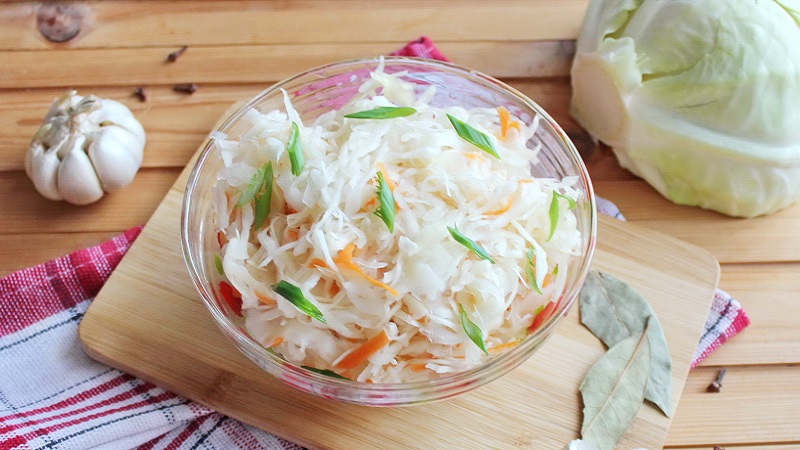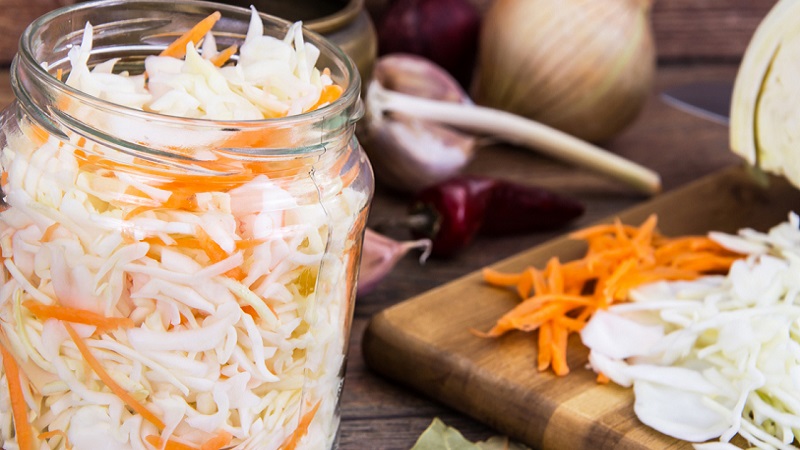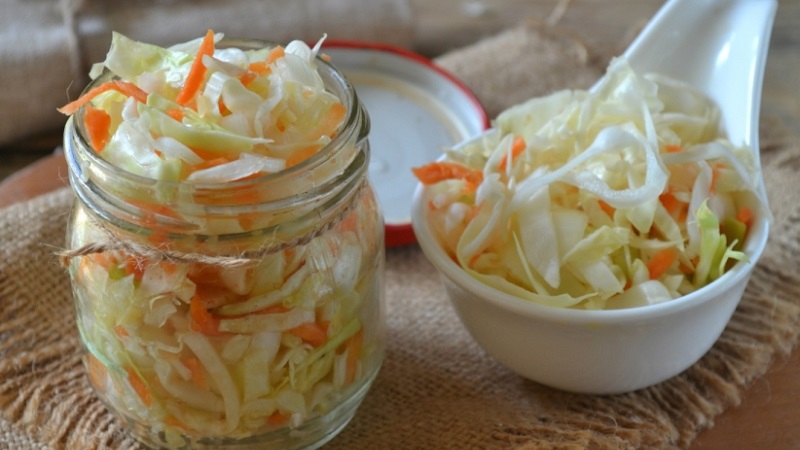We make preparations wisely: why sauerkraut becomes soft, does not crunch and how to avoid it
It happens that sauerkraut turns out to be soft, and not crispy, as it should be. This is caused by cooking errors, non-observance of the specified amount of ingredients or temperature conditions during storage.
We will figure out how to properly ferment a vegetable and avoid spoiling the finished dish.
The content of the article
Reasons for the softness of sauerkraut
Cabbage, which has become soft during pickling, will no longer return its former crunchiness and elasticity.... With proper active fermentation, lactic acid bacteria affect the vegetable. The released lactic acid inhibits the development of other microorganisms, makes the snack crispy and pleasantly sweet and sour.
To get a quality dish, take only fresh ingredients.

Causes in a cabbage fork
When choosing heads of cabbage, pay attention to their color, density and juiciness.... For fermentation, dense specimens without damage and rot, peeled from the upper green leaves, are suitable.
If released during salting not enough fluid, the formation of a lactic acid environment is disturbed, and putrefactive bacteria prevail over useful ones. As a result, cabbage not only becomes soft, but also acquires an unattractive grayish tint and loses its pleasant taste.
Early varieties that have not yet accumulated enough sugar are not suitable for fermentation... Without sugar, the fermentation process will not begin, the vegetable will turn sour in the brine and become soft. Late and mid-season varieties are chosen for pickling - such preparations are crispy and juicy, preserve vitamins and other valuable compounds.
Reference! Housewives are guided by the shape of the heads: round and slightly flattened specimens grow in late varieties and are well suited for fermentation.
Salting errors
One of the common reasons why sauerkraut becomes soft and does not crunch is a violation of the technology of its preparation.... Cut the vegetable across the veins, not lengthwise. Too finely chopped forks will also turn into a softened mass, so the pieces are left medium in size (about 5-6 mm thick).

No less frequent violations:
- adding sugar - in some recipes it is used to speed up and intensify fermentation, but it makes cabbage soft and slimy;
- grinding a chopped vegetable in a small container - it is better to choose a large container so that, when mixing, the product is enriched with oxygen necessary for oxidative reactions;
- lack of brine - the liquid is poured so that it completely covers the tamped vegetables, top up if necessary;
- excess or lack of salt - the optimal amount: 1.5 tbsp. l. for 1 liter of water or 20 g for 1 kg of the main ingredient.
After salting the vegetable cans are stored in a warm place in the first 2-3 days... Then they are transferred to a cool cellar or refrigerator, otherwise the snack will acidify and become soft.
Unsuitable cookware
For fermentation, cans with a volume of 2-3 liters are suitable... In huge tubs or barrels, the product is slowly eaten up and softens due to long storage. Do not harvest cabbage in enamel, plastic and metal dishes: interaction with metal will give the vegetable a dark, unappetizing shade.
Important! In containers made of aluminum or stainless steel, the snack becomes dangerous to health: the resulting acid corrodes the walls of the dishes, absorbing the released harmful substances.
Glass or wooden containers work well.
Excess carrots
Carrots are often added to the snack, which gives a special aroma, pleasant sweetness and even increases crunchiness. However too many root crops disrupt fermentation processes.

The optimal amount of carrots - 1/3 of the total volume of cabbage.
Is it possible to eat such cabbage
There is no danger from eating a soft snack, but its taste deteriorates... This product is added to soups, salads, pies in the form of filling and even fried.
Dark color snack with an unpleasant odor or mold are thrown away.
Other troubles
Sometimes sauerkraut becomes "snotty", covered with a slippery bloom and loses its pleasant crunchiness. The reason for this is the excess carbon dioxide accumulating in the bank. Therefore, a wooden stick is inserted into the container so that the gas can easily escape.
The bitter taste of a vegetable — consequence of an incorrectly chosen head of cabbage... Such cabbage was frozen or fertilized with chemicals during cultivation.
So that the appetizer does not become soft, only take for pickling table salt, not iodized.
How to ferment cabbage correctly
Salting technology, choice of products and storage temperature are important conditions for obtaining a quality snack.
Interesting! Some hostesses are guided by the phase of the moon: heads of cabbage, harvested 3-4 days after the new moon, are the most crisp.
The classic way of fermentation:
- Chop 3 kg of cabbage.
- Grate coarsely 800 g of carrots.
- Mix the chopped head of cabbage with 60 g of salt, mash slightly, add carrots.
- Put the vegetable mass in a clean dry jar, tamping tightly.

Place the container in a deep bowl to drain the secreting juice and foam.... When fermenting in a saucepan, put oppression - a plate with a heavy object or a bottle of water. Daily mix pierced with a wooden stickto eliminate the gas.
The appearance of a cloudy solution and the formation of foam is a natural process, indicating active fermentation and correct leavening.
Useful tips from experienced housewives
Vegetables are chopped across the grain using a knife or a special grater... In a large container, the cabbage is mixed with salt. It is not squeezed out strongly, but slightly crumpled.
When preparing a product in its own juice leave 3-4 cm of free space in the containerso that escaping liquid does not overflow over the edges. If brine is used, all ingredients are completely covered with it.
Adding sugar - an individual matter. It will speed up fermentation, but also add unwanted softness.
Other ingredients will retain crispness:
- carrot;
- bell pepper;
- beet;
- slices of apples;
- pulp of plums;
- cherries or cranberries;
- marinated mushrooms;
- salted cucumbers.
Horseradish leaves are placed on top to add aroma and preserve the elasticity of cabbage... Spices will also not interfere: allspice, cloves, cumin.
Conclusion
The crispy and flavorful sauerkraut is the result of a simple effort. The dish turns out to be tasty and healthy if you follow the cooking technology, use high-quality late-ripening heads of cabbage without damage.
To prevent vegetables from becoming too salty and soft, they are kept warm for only 2-3 days at temperatures up to + 23 ° C, but not lower than + 19 ° C, and then put away in the cold.